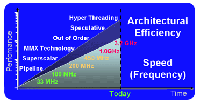Intel: Architecturing the Era of Tera

In his keynote speech at the Spring 2004 Intel Developer Forum, Intel senior vice president and CTO Pat Gelsinger talked about the future of computing in the "era of tera." Gelsinger outlined the massive proliferation of digital data, and envisioned a future where low-cost, high-performance computing power allows individuals and businesses to reap the benefits of all this digital information.
Although we don't see it, we live in a sea of digital data. A digital transformation is underway. Anything that can be digitally recorded is being recorded. Researchers assert that for each person on the planet roughly 800 megabytes of data are recorded annually. And the amount of that data is doubling every 18-24 months. In fact, worldwide data is growing so fast that it's now measured by the exabyte — a million terabytes.
Today only giant corporations have access to the supercomputing power needed to pull information out of such large amounts of data. Making this level of high-performance computing accessible to anybody, even small businesses and consumers, will create tremendous opportunities for new goods and services, improve critical decision making, and enrich our everyday lives.
Computing in the Era of Tera
Historically, we have seen several leaps in computing capability:
- From the mainframe to the personal computer
- From the command line to the GUI (graphical user interface)
- From text-based data to today's rich multimedia data types
Together speed and architectural innovation are a driving force behind these leaps in performance and capability, and will continue.
Today we have gigabytes of photos, music, and video on our systems being processed by gigahertz platforms. Tomorrow, there will be terabytes of digital data that will require teraflops of processing power to manage, analyze, and synthesize meaningful information.
Between 1999 and 2002 new data stored on electronic media grew by 30 percent, according to a recent report by the University of California, Berkeley. The same study says that print, film, magnetic, and optical storage media produced about 5 exabytes of new information in 2002 — that's equal to nearly half a million new Libraries of Congress.
To manage this explosion of data and convert it into information will require innovative and "smarter" computing architectures. These architectural innovations will provide new opportunities in personal computing on a scale not previously seen. These innovations may enable anyone to use powerful computing platforms to take advantage of the digital transformation.
Tomorrow's Computing Workloads
To develop this architectural paradigm requires understanding the workloads of tera-era computing.
Tera-level computing involves three distinct types of workloads, or computing capabilities:
- Recognition: the ability to recognize patterns and models of interest to a specific user or application scenario.
- Mining: the ability to mine large amounts of real-world data for the patterns or models of interest.
- Synthesis: the ability to synthesize large datasets or a virtual world based on the patterns or models of interest.
Today, we have application-specific architectures optimized for a single workload. We don't expect an enterprise server to do real-time rendering, and we don't use 3D graphics engines to do database sweeps.
In the future, as the amount of data continues to grow, the computing capabilities for recognition, mining and synthesis (RMS) workloads are converging. Each type of workload, while very different, will require teraflops of processing capability applied to massive data streams. This convergence enables the creation of a new architecture that can meet all three workload requirements — recognition, mining, and synthesis — on a single platform.
Workloads Converge on the Platform
The implication of these converging capabilities requires a fundamental rethinking of how to deliver new levels of performance. Clearly, monolithic architectures will not satisfy future workload demands. The amount of work being done per clock cycle will need to increase ten times, or even a hundred times.
Intel foresees a multicore architecture that is scalable, adaptable, and programmable. This new architectural paradigm is what can propel the industry into the tera era.
Intel research and development teams are working across the globe to create the technologies that will establish tera-era computing.
Intel Senior Vice President and Chief Technology Officer,Pat Gelsinger, in his Spring 2004 IDF keynote asserted that new architectural innovations will be required to spur the next leap in computing and communications. Gelsinger explained the drivers and enablers that Intel and the industry must harness to take advantage of architectural innovations that will provide the industry with new opportunities for growth and unparalleled increases in performance.
"Our society is creating massive amounts of complex data as the world continues to go digital, but it doesn't have the capability to enjoy the full potential of this rich resource," said Gelsinger. "There is a critical need for scalable, adaptable and programmable computing architectures that have the capability to recognize, mine and synthesize all of this digital data."
By examining the RMS workloads, Gelsinger discussed the implications these workloads will have on future computing architectures. Clearly, innovative, multicored architectures will be developed to address the multifaceted requirements that recognition, mining and synthesis workloads will place on computing platforms as the tera era emerges.
The original release can be found on Intel web-site.
Read the full keynote transcript of Gelsinger's speech for more details.
Read the interview with Steve Pawlowski, Intel Fellow and head of Intel's Microprocessor Technology Lab (MTL), about new computing architectures being investigated at MTL.




















